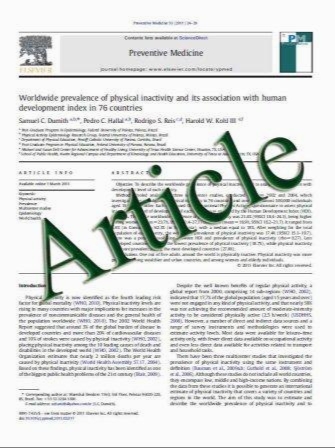High prevalence of vitamin D deficiency among healthy Saudi Arabian men: relationship to bone mineral density, parathyroid hormone, bone turnover markers, and lifestyle factors
- نوع فایل : کتاب
- زبان : انگلیسی
- مؤلف : M.-S. M. Ardawi & A. M. Sibiany & T. M. Bakhsh & M. H. Qari & A. A. Maimani
- چاپ و سال / کشور: 2011
Description
Summary In this cross-sectional study, the prevalence of vitamin D deficiency [serum 25-hydroxyvitamin D (25 (OH)D) <50 nmol/L] was 87.8% among Saudi Arabian men. There was a linear inverse relationship between serum 25(OH)D and intact parathyroid hormone (PTH) levels, but without a threshold of 25(OH)D at which intact PTH values plateaued. Introduction Vitamin D insufficiency and/or deficiency has now reached epidemic proportions and has been linked to low bone mineral density (BMD), some lifestyle factors, and obesity in adults. This relationship is not well documented in Saudi Arabian men. This study examines the relationship between vitamin D status, intact parathyroid hormone (intact PTH), and lifestyle factors among Saudi Arabian men. Methods This cross-sectional study involved 834 men aged 20.74 years living in Jeddah area who were randomly selected and medically examined. Men had their BMD (lumbar spine (L1.L4) and neck femur), 25(OH)D, intact PTH, and other parameters measured according to detailed inclusion criteria. Results Deficiency (25(OH)D<50 nmol/L) and insufficiency (.50.75 nmol/L) were present in 87.8% and 9.7%, respectively. Deficiency was common among older and obese men with no education and sedentary lifestyle sampled during summer and spring. Serum 25(OH)D showed an inverse linear relationship with intact PTH, but there was no threshold of serum 25(OH)D at which PTH levels plateaued. There was a positive correlation between BMD values at both lumbar spine (L1.L4) (P<0.023) and neck femur (P<0.036) and serum 25(OH)D levels, respectively. Conclusions Functionally significant vitamin D deficiency affects BMD and bone turnover markers among Saudi Arabian men and is largely attributed to older age, obesity sedentary lifestyle, no education, poor exposure to sunlight, smoking, and poor dietary vitamin D supplementation. The data suggest that an increase in PTH cannot be used as a marker for vitamin D deficiency.
Osteoporos Int DOI 10.1007/s00198-011-1606-1 Received: 29 November 2010 / Accepted: 1 March 2011


